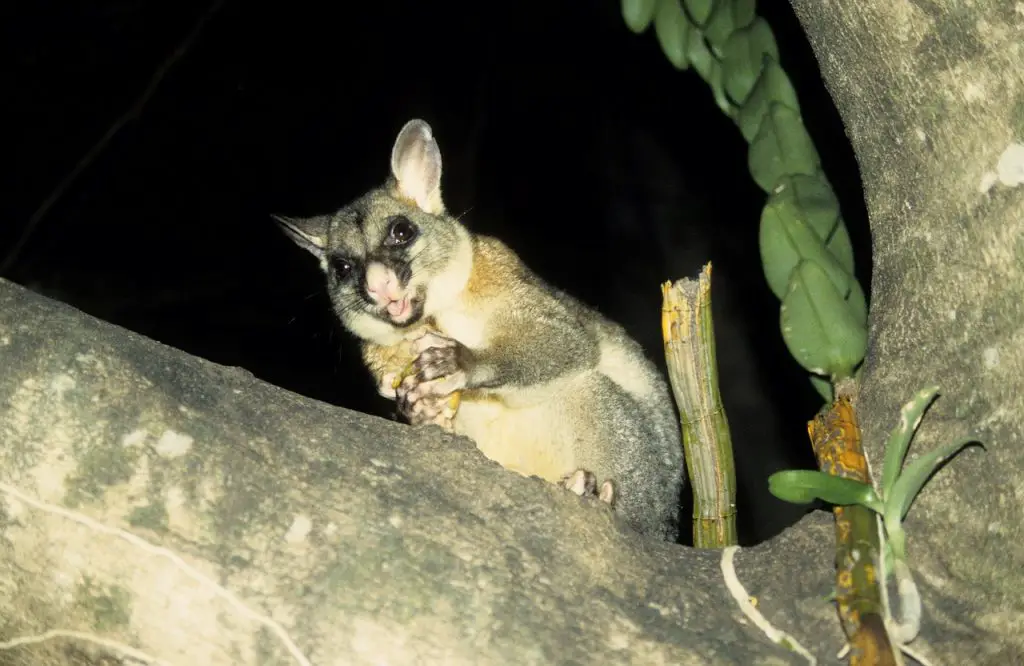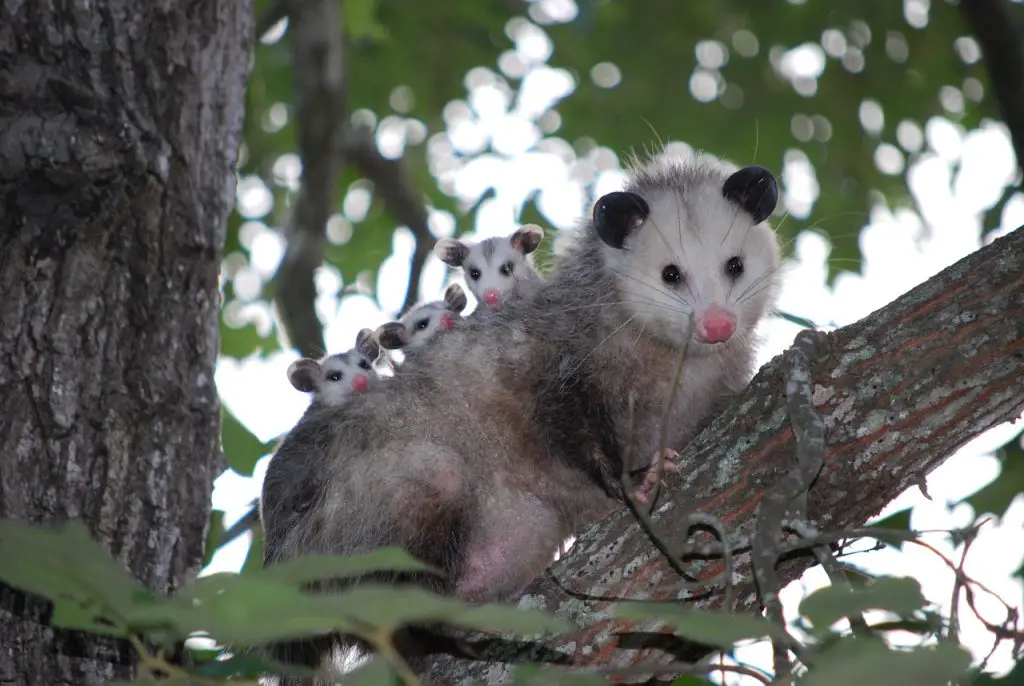When you think of possums vs opossums, you might not realize these words represent two distinct animals. With the name similarities, it’s easy to get confused. But it’s critical to clarify that possums and opossums are two different animals. We will explore everything you want to know about how these animals are different.
Key facts:
- Although the names sound similar, possums and opossums are two different animals.
- Both possums and opossums are marsupials.
- Possums live in Australia. Opossums live in North and South America.
Possums vs Opossums: An Overview
| Possum | Opossum | |
| Diet | Herbivore | Opportunitistic omnivore |
| Distribution | Australia | North and South America |
| Tail type | Fluffy | Hairless |
Possums vs Opossums: Species Breakdown
While the common names are spelled similarly, possums and opossums are two difference species.
Opossum Species
Here is a breakdown of the some of the most common opossum species:
- Common opossum (Didelphis marsupials): This is the most well-known and widespread opossum species, found in North America. It has a grayish fur coat and a long, hairless tail.
- Virginia opossum (Didelphis virginiana): Native to Central and South America, this species has a similar appearance to the Virginia opossum but is slightly smaller in size.
- Yapok or water opossum (Chironectes minimus): Found in Central and South America, this unique species is semiaquatic and has webbed feet for swimming. It has a sleek body and a long, flattened tail.
- Woolly opossum (Caluromys lanatus): Native to Central and South America, this species has a dense and woolly fur coat. It possesses a long, bushy tail and large, round eyes.
Possum Species
Here’s a breakdown of some of the most common possum species:
- Common brushtail possum (Trichosurus vulpecula): Native to Australia, this species is one of the most well-known and widespread possums. It has a bushy tail and thick fur, with variations in color from gray to brown.
- Common ringtail possum (Pseudocheirus peregrinus): Found in Australia, this species has a long, prehensile tail with a distinctive white tip. It has a compact body and a round face.
- Mountain brushtail possum (Trichosurus cunninghami): Native to the mountainous regions of eastern Australia, this possum species has a dense and woolly fur coat. It is larger in size compared to the common brushtail possum.
- Leadbeater’s possum (Gymnobelideus leadbeateri): Also known as the fairy possum, it is a critically endangered species native to Australia. It has a compact body, large ears, and a long tail.
Possums vs Opossums: Physical Differences
Possums, commonly found in Australia and nearby regions, have a distinctive appearance. They are characterized by their fluffy fur, pointed snouts, and rounded ears. Their fur coloration can vary, ranging from gray to brown, depending on the species. Possums have a prehensile tail, which means they can use it to grasp and hold onto branches as they navigate through trees. Their tails play a crucial role in maintaining balance and aiding in climbing.
Here’s a picture of a possum:

In contrast, opossums, primarily found in North and South America, have a different physical appearance. They possess coarse fur and a rat-like appearance. Opossums have a unique feature: a long, hairless tail that serves as a multifunctional tool. They can use their tail to grip tree branches and hang upside down, similar to a monkey’s tail. Unlike possums, opossums have a more robust build, with some species reaching larger sizes.
Here’s a picture of an opossum:

Furthermore, the dental structures of possums and opossums differ. Possums have sharp, pointy teeth with prominent canines. They use their teeth to crush fruits, nuts, and small prey. On the other hand, opossums have a unique dental formula, possessing 50 teeth, more than any other North American mammal. Their mouth structure enables them to consume a wide range of foods, including insects, small mammals, and carrion.
Possums vs Opossums: Geographic Distribution
The creatures have distinct geographic distributions, primarily due to their evolutionary paths and historical factors. Possums are predominantly found in Australia and nearby regions. They have successfully adapted to various habitats across the continent, including forests, woodlands, and urban areas. The common brushtail possum, for example, thrives in both rural and urban environments throughout Australia, while the mountain brushtail possum is restricted to the mountainous regions of eastern Australia. Additionally, the sugar glider is endemic to Australia, Indonesia, and New Guinea, where it inhabits forests and woodlands.
On the other hand, opossums are primarily distributed in the Americas, particularly in North and South America. The Virginia opossum, the most widely recognized opossum species, is native to North America and can be found from Canada to Central America. It has successfully adapted to various habitats, including forests, swamps, and urban areas. In South America, different opossum species, such as the common opossum and the water opossum, can be found in countries like Brazil, Argentina, and Venezuela. Each opossum species has its own specific range and preferred habitat within these regions.
Possums vs Opossums: Name Pronunciation
Possum, referring to the Australian and nearby species, is commonly pronounced as “PAH-suhm” in Australian English. The emphasis is typically placed on the first syllable, and the “o” is often pronounced as a short “o” sound. However, in some regions, such as New Zealand, the pronunciation may vary slightly, with a longer vowel sound, giving it a closer resemblance to “PAW-suhm.”
In contrast, opossum, the term used for the North and South American species, is generally pronounced as “uh-POS-uhm” in American English. The emphasis is placed on the second syllable, and the “o” is often pronounced as a short “o” sound. However, it’s important to note that even within North America, there can be slight variations in pronunciation. For instance, some individuals may pronounce it as “oh-POS-uhm” with a slightly elongated vowel sound.
Possums vs Opossums: Behavioral Differences
Possums are primarily arboreal creatures. They are known for their excellent climbing and balancing abilities. Possums are nocturnal animals, meaning they are most active during the night. They spend their days resting in tree hollows or dens. When night falls, they emerge in search of food, which mainly consists of fruits, leaves, nectar, and occasionally small insects or small vertebrates. Possums are also territorial and mark their territories using scent glands. They are generally solitary animals, except during the breeding season when they come together for mating.
In contrast, opossums have different behavioral patterns. Opossums are opportunistic omnivores, meaning they have a varied diet and will eat almost anything they can find. They exhibit scavenging behavior, often feeding on carrion or roadkill. Unlike possums, opossums primarily live on the ground animals, although they are also capable climbers. They are primarily active during the night, but some species, such as the Virginia opossum, may be active during twilight hours as well. Opossums have a relatively short lifespan and tend to have shorter home ranges compared to possums.
Another notable behavioral difference is their response to threats. When faced with danger, opossums have a defensive behavior known as “playing possum.” They feign death by going limp, lying on their side, and even sticking out their tongue to mimic a deceased animal. This response is a defense mechanism to deter predators.
Possums vs Opossums: Diet
Possums have a primarily herbivorous diet, meaning their diet primarily consists of leaves, buds, flowers, and fruits. The animals have adapted to feed on a variety of vegetation, including eucalyptus leaves, which are a staple in their diet. They also consume nectar from flowers, making them important pollinators in their ecosystems. Additionally, possums may occasionally supplement their diet with small insects, invertebrates, or small vertebrates, but these make up a small portion of their overall food intake.
In contrast, opossums are opportunistic omnivores. They have a much broader diet compared to possums. Opossums are known for their scavenging behavior and have a remarkable ability to consume a wide range of food sources. Their diet includes fruits, berries, nuts, insects, small mammals, reptiles, amphibians, birds, eggs, carrion, and even garbage. Opossums play an important ecological role as scavengers, helping to clean up the environment by consuming carrion and other organic matter.
In fact, opossums are known for their remarkable ability to eat almost anything they encounter, giving them the title of “nature’s garbage disposals.” Their omnivorous diet allows them to adapt and survive in diverse habitats and take advantage of various food sources available to them.
Frequently Asked Questions
You have questions about Possums vs Opossums. I have answers.
Are a possum and opossum the same?
No. A possum and an opossum are two very different species. One lives in North America, the other lives in Australia.
Are possums mean or aggressive?
Neither a possum nor an opossum is generally considered mean or aggressive. However, both species are wild animals that could bite if they feel threatened. With that, it’s best to give these animals plenty of space.
Do possums or opossums carry rabies?
It is extremely rare for an opossum to carry rabies. With a low body temperature, these mammals seem less susceptible to the rabies virus. But when possible, it’s best to avoid handling wild animals.
Final Take on Possums vs Opossums
Possums and opossums, despite sharing a similar name, are two distinct creatures with notable differences in physical characteristics, geographic distribution, behavior, and diet.
Possums, native to Australia and nearby regions, exhibit fluffy fur, pointed snouts, and prehensile tails, and they are primarily herbivorous, with a focus on leaves, buds, and fruits. Opossums, found in the Americas, possess coarse fur, rat-like appearances, and long hairless tails, and they are opportunistic omnivores, known for their scavenging behavior and ability to consume a wide range of food sources.
Understanding these distinctions allows us to appreciate the unique adaptations and ecological roles of possums and opossums, highlighting the diverse and fascinating world of marsupials in different parts of the globe. Plus, you won’t have to stay in the haze of confusion surrounding these two very different creatures.